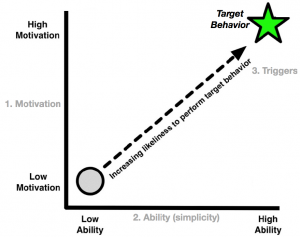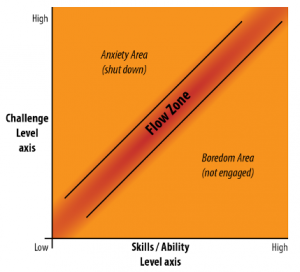In the field of psychology, motivation can be categorized as intrinsic or extrinsic. Extrinsic motivation (such as monetary rewards) is driven by the environment, while intrinsic motivation is driven by the personal will. Moreover, extrinsic motivators usually lose their impact over the time, when becoming a routine, requiring the increase of the levels of these motivators. On the other hand, intrinsic motivation is more sustainable as the motivators are integrated into the person’s values and goals.
 There is a behavioral model proposed by a researcher from Stanford University [1]. It defines a path from an existing behaviour to a target behaviour using three main factors: motivation, ability and triggers. The core motivators are pleasure/pain (instant reactions), hope/fear (outcome expectations) and acceptance/rejection (social behavior). Abilities are also described as simplicity factors that should be kept simple enough to make a person reach a target behavior. These are detailed as time, money, physical effort, brain cycles (thinking effort), social deviance (the difference from general rules of society) and non-routine (difference from routine jobs). Finally triggers that can be used as sparks (for people with low motivation, targeting a core motivation), facilitators (for people with high motivation, but low ability, simplifying a task) and signals (when there is both motivation and ability, but to remind the change in behaviour).
There is a behavioral model proposed by a researcher from Stanford University [1]. It defines a path from an existing behaviour to a target behaviour using three main factors: motivation, ability and triggers. The core motivators are pleasure/pain (instant reactions), hope/fear (outcome expectations) and acceptance/rejection (social behavior). Abilities are also described as simplicity factors that should be kept simple enough to make a person reach a target behavior. These are detailed as time, money, physical effort, brain cycles (thinking effort), social deviance (the difference from general rules of society) and non-routine (difference from routine jobs). Finally triggers that can be used as sparks (for people with low motivation, targeting a core motivation), facilitators (for people with high motivation, but low ability, simplifying a task) and signals (when there is both motivation and ability, but to remind the change in behaviour).
 Another useful tool to achieve gamification objectives is player progression [2]. The gamified process is desired to make players improve their skills over the time and, as result, their performance improves. A correlated term for performance is the level of challenge. There should be a balance between the player skills and game challenges. A highly skilled player facing a low level of challenge could become bored (not engaged); while an amateur player, dealing with difficult objectives may become anxious and leave playing.
Another useful tool to achieve gamification objectives is player progression [2]. The gamified process is desired to make players improve their skills over the time and, as result, their performance improves. A correlated term for performance is the level of challenge. There should be a balance between the player skills and game challenges. A highly skilled player facing a low level of challenge could become bored (not engaged); while an amateur player, dealing with difficult objectives may become anxious and leave playing.
References
[1] Fogg, B.J. A behavior model for persuasive design. in: 4th International Conference on Persuasive Technology, 2009, pp. 1-7.
[2] Zichermann, G., Cunningham, C. (2011). Gamification by design: Implementing
game mechanics in web and mobile apps. O’Reilly Media, Sebastopol, US.

Comments are closed.